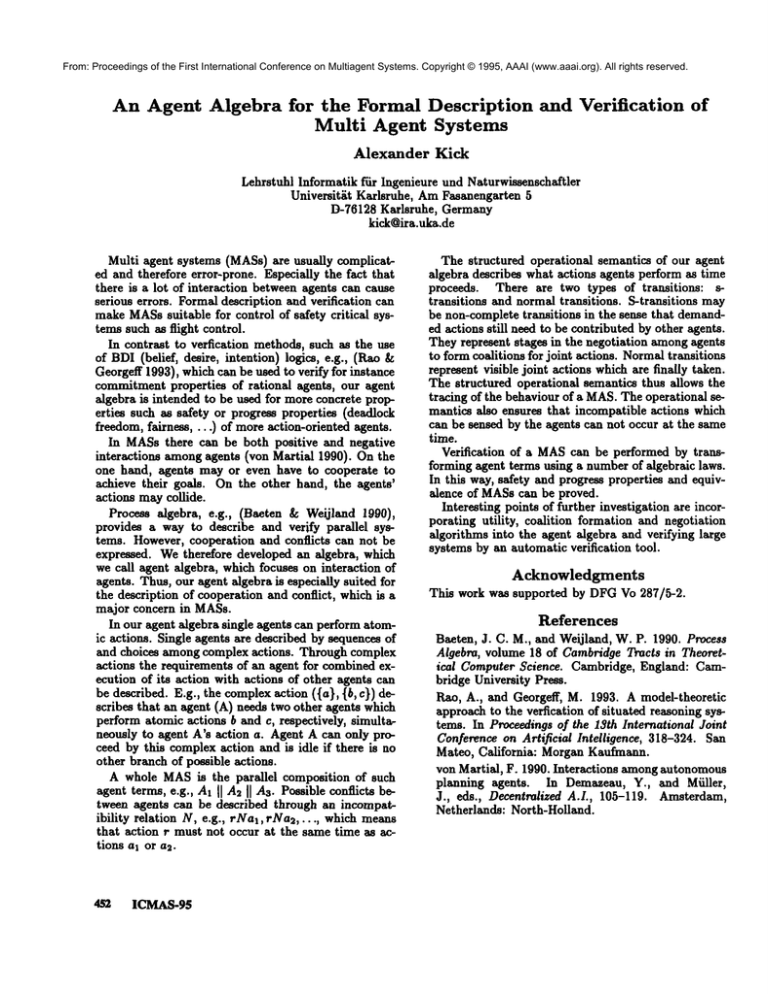
From: Proceedings of the First International Conference on Multiagent Systems. Copyright © 1995, AAAI (www.aaai.org). All rights reserved.
An Agent Algebra
for
the Formal Description
Multi Agent Systems
and Verification
of
Alexander Kick
Lehrstuhl Informatik fiir Ingenieure und Naturwissenschaftler
UniversitKt Karlsruhe, AmFasanengarten 5
D-76128 Karisruhe, Germany
kick@ira.uka.de
Multi agent systems (MASs)are usually complicated and therefore error-prone. Especially the fact that
there is a lot of interaction between agents can cause
serious errors. Formal description and verification can
make MASssuitable for control of safety critical systems such as flight control.
In contrast to verfication methods, such as the use
of BDI(belief, desire, intention) logics, e.g., (Rao
Georgetf 1993), which can be used to verify for instance
commitment properties of rational agents, our agent
algebra is intended to be used for more concrete properties such as safety or progress properties (deadlock
freedom, fairness, ...) of more action-oriented agents.
In MASsthere can be both positive and negative
interactions among agents (yon Martial 1990). On the
one hand, agents may or even have to cooperate to
achieve their goals. On the other hand, the agents’
actions may collide.
Process algebra, e.g., (Baeten & Weijland 1990),
provides a way to describe and verify parallel systems. However, cooperation and conflicts can not be
expressed. Wetherefore developed an algebra, which
we call agent algebra, which focuses on interaction of
agents. Thus, our agent algebra is especially suited for
the description of cooperation and conflict, which is a
major concern in MASs.
In our agent algebra single agents can perform atomic actions. Single agents are described by sequences of
and choices among complex actions. Through complex
actions the requirements of an agent for combined execution of its action with actions of other agents can
be described. E.g., the complexaction ({a), {b, c))
scribes that an agent (A) needs two other agents which
perform atomic actions b and c, respectively, simultaneously to agent A’s action a. Agent A can only proceed by this complex action and is idle if there is no
other branch of possible actions.
A whole MASis the parallel composition of such
agent terms, e.g., AI II A2II A3. Possible conflicts between agents can be described through an incompatibility relation N, e.g., rNal, rNa2,..., which means
that action r must not occur at the same time as actions al or a2.
4$2
ICMAS-9$
The structured operational semantics of our agent
algebra describes what actions agents perform as time
proceeds. There are two types of transitions:
stransitions and normal transitions. S-transitions may
be non-complete transitions in the sense that demanded actions still need to be contributed by other agents.
They represent stages in the negotiation amongagents
to form coalitions for joint actions. Normaltransitions
represent visible joint actions which are finally taken.
The structured operational semantics thus allows the
tracing of the behaviour of a MAS.The operational semantics also ensures that incompatible actions which
can be sensed by the agents can not occur at the same
time.
Verification of a MAScan be performed by transforming agent terms using a number of algebraic laws.
In this way, safety and progress properties and equivalence of MASscan be proved.
Interesting points of further investigation are incorporating utility, coalition formation and negotiation
algorithms into the agent algebra and verifying large
systems by an automatic verification tool.
Acknowledgments
This work was supported by DFGVo 287/5-2.
References
Baeten, J. C. M., and Weijland, W. P. 1990. Process
Algebra, volume 18 of Cambridge Tracts in Theoretical Computer Science. Cambridge, England: Cambridge University Press.
Rao, A., and Georgeff, M. 1993. A model-theoretic
approach to the verfication of situated reasoning systems. In Proceedings of the 13th International Joint
Conference on Artificial Intelligence, 318-324. San
Mateo, California: Morgan Kaufmann.
yon Martial, F. 1990. Interactions among autonomous
planning agents. In Demazeau, Y., and Miiller,
J., eds., Decentralized A.I., 105-119. Amsterdam,
Netherlands: North-Holland.
